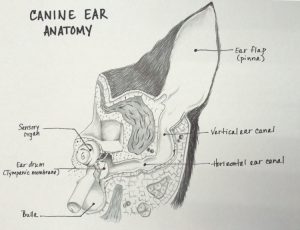Dogs, like people, get ear wax build up. This alone can cause pain, decreased hearing, and dizziness. But add to that the increased risk of a yeast infection, bacterial infection and even parasites in the ear and you can see that inspecting and maintaining your dog’s ears is important to their overall health. This is especially important for dogs with floppy ears.
Ear Anatomy
 A dog’s ear canal is L shaped with a vertical canal that connects to a horizontal canal deeper withing the skull. Dirt, wax, and parasites such as ear mites can hide in the horizontal canal. We cannot access that canal, so we need to use regular flushing to remove debris that may cause a blockage. We also don’t want to risk damaging the tympanum by poking implements such as Q-tips down there.
A dog’s ear canal is L shaped with a vertical canal that connects to a horizontal canal deeper withing the skull. Dirt, wax, and parasites such as ear mites can hide in the horizontal canal. We cannot access that canal, so we need to use regular flushing to remove debris that may cause a blockage. We also don’t want to risk damaging the tympanum by poking implements such as Q-tips down there.
How Often?
Generally speaking, any time you bathe the dog you should inspect her ears and clean them as well if needed. Dogs who are prone to ear trouble should be checked and cleaned weekly. Floppy eared dogs tend to have more trouble with ear dirt and infections that standup eared dogs.
Preparation
You will need:
- A comfortable place to work on your dog. For small dogs, a raised surface such as a table, sofa, or bed.
- You will probably need a helper to hold the dog while you perform the needed procedure.
- Some ear cleaning solution (discussed later)
- Two small bowls
- An ear bulb or syringe large enough to hold enough cleaner for one ear (35 ml for large dogs)
- This will be messy, if you’re working on furniture you will want to cover it with and old blanket.
- Have some 2″x2″ gaze pads or cotton balls and some cotton tipped swabs handy
- And of course a suitable treat to give after each ear is done.
The First Step
The first thing to do is to inspect the ears. What you will be looking for are:
- Black “dirt” which can be just that: dirt, or the excrement of eat mites.
- Red-brown ear wax
- Embedded ticks
- Redness of the skin and or injury such as scratches or sores.
If you find injury or redness, you will probably want to consult your veterinarian for diagnosis and treatment. If this is an on-going issue and you know what is going on you may proceed.
Remove any ticks with tweezers or a tick puller, be careful not to scrape or poke the ear and cause injury.
Use gauze or swabs to carefully wipe out any dirt and wax from the pina and upper (vertical) ear canal. Get into the folds and structures of the ear, but do not damage them. Do not attempt to go into the horizontal canal.
If you notice a funky smell inside your dog’s ear, that’s a yeast infection and you need to see your vet for medication.
The next step is washing the ear.
Cleaners
For routine cleaning, there are a number of commercially made cleaners available without prescription through pet stores: Zymox, Epi-Otic, and Oti-Clens are just a few of the more popular names. These are formulated to clean and break up wax. But you can make your own cleaner if you want.
A 1:1 mix of 3% hydrogen peroxide and water works well as a wash. If you’d rather avoid the peroxide, use vinegar (apple cider or white) instead, use a 1:1 mix. Both solutions remove dirt and provide a mild antiseptic value. Neither of these solutions dissolve wax, but will help to wash out minor wax deposits. Do NOT use either of these if the ears show redness or injury as they will cause your dog pain. Never use rubbing alcohol, this dries out the skin and promotes ear infections.
If the ears are inflamed or injured, use olive oil with vitamin E oil or aloe vera added. You can use aloe vera gel or Vitamin E oil straight as a medication, but for cleaning we need a larger amount and a more liquid consistency. Depending on the size of your dog, put between 10 ml and 35 ml of olive oil (per ear) in each bowl. Open and add from 1 to 4 vitamin E capsules and extract the oil into the olive oil. Or use 1/4 tsp to 1 tsp aloe vera gel. Mix together and use a properly sized syringe or ear bulb to suck up all the mixture so it can all be inserted in one go per ear.
Whatever ear cleaner you use, it will help to allow the solution to come to room temperature before putting it into your dogs ears, they are sensitive to cold.
The Process
Use the syringe or ear bulb to suck up enough cleaner to fill one ear canal (35 ml for a large dog) and dispense it into the ear canal. Once it’s in begin massaging the base of your dogs ear to work the fluid into the ear and break up the gunk. You will hear a sloshy-sucking sound when you’re doing this right. Massage for 30 seconds to 1 minute, then duck as your dog shakes the solution and debris out.
Go back in with gauze and swabs and carefully remove any more debris that has been loosened.
Give a treat for being a good dog.
Repeat for the other ear.
Summary
If done regularly, ear cleanings will help you keep your dogs ears healthy and free of wax, dirt, and pests. Once your dog gets used to it, the process becomes quick and less of an ordeal for both of you. Be sure to reward good behavior.
| If you enjoy our pupdates, Doggy Tales, and educational articles consider subscribing for notices when new pieces are posted. It’s painless and you can unsubscribe any time you want. Your e-mail address is used ONLY to deliver these notices. | [email-subscribers namefield=”YES” desc=”” group=”Public”] |



